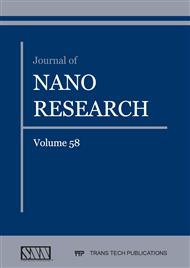[1]
M. Bielmann, P. Schwaller, P. Ruffieux, O. Gr¨oning, L. Schlapbach, and P. Gr¨oning, AgO investigated by photoelectron spectroscopy: evidence for mixed valence,, Physical Review B, vol. 65, no. 23, (2002) 235431-235435.
DOI: 10.1103/physrevb.65.235431
Google Scholar
[2]
J.A. McMillan Magnetic properties and crystalline structure of AgO, Journal of Inorganic and Nuclear Chemistry, Volume 13, Issues 1–2, April 1960, Pages 28-31.
DOI: 10.1016/0022-1902(60)80231-x
Google Scholar
[3]
B. Standke, M. Jansen, J. Solid State Chem. Inorganic Syntheses: Nonmolecular Solids 67 (1987) 278.
Google Scholar
[4]
B. Standke, M. Jansen: Ag3O4, das erste Silber (II, III)-oxid , Angew. Chem. 98 (1986) 76- 90.
DOI: 10.1002/ange.19860980107
Google Scholar
[5]
C. Karunakaran, V. Rajeswari, P. Gomathisankar, Optical, electrical,photocatalytic, and bactericidal properties of microwave synthesizednanocrystalline Ag ZnO and ZnO, Solid State Sci. 13 (2011) 923–928.
DOI: 10.1016/j.solidstatesciences.2011.02.016
Google Scholar
[6]
B. Subash, A. Senthilraja, P. Dhatshanamurthi, M. Swaminathan, M. Shanthi,Solar active photocatalyst for effective degradation of RR 120 with dyesensitized mechanism, Spectrochim. Acta A 115 (2013) 175-182.
DOI: 10.1016/j.saa.2013.06.027
Google Scholar
[7]
E.I. Alarcon, K. Udekwu, M. Skog, N.L. Pacioni, K.G. Stamplecoskie, M.González-Béjar, N. Polisetti, A. Wickham, A. Richter-Dahlfors, M. Griffith, J.C. Scaiano, The biocompatibility and antibacterial properties ofcollagen-stabilized, photochemically prepared silver nanoparticles, Biomaterials 33 (19) (2012) 4947-4956.
DOI: 10.1016/j.biomaterials.2012.03.033
Google Scholar
[8]
Ju-Mei Li, Wan-Fu Ma, Chuan Wei, Li-Jun You, Jia Guo, Jun Hu, Chang-ChunWang, Detecting trace melamine in solution by SERS using Ag nanoparticlecoated poly (styrene-co-acrylic acid) nanospheres as novel active substrates, Langmuir 27 (23) (2011) 14539- 14544.
DOI: 10.1021/la203049k
Google Scholar
[9]
X. Zheng, X. Zhao, D. Guo, B. Tang, S. Xu, B. Zhao, W. Xu, Photochemicalformation of silver nanodecahedra: structural selection by the excitationwavelength, Langmuir 25 (2009) 3802-3807.
DOI: 10.1021/la803814j
Google Scholar
[10]
P.P. Sahay, R.K. Nath, "Al-Doped ZnO Thin Films as Methanol Sensors, Sens. Actuators B134 (2008) 654–659.
DOI: 10.1016/j.snb.2008.06.006
Google Scholar
[11]
B.G. Yacobi, Semiconductor Materials: An Introduction to Basic Principles, Kluwer Academic/Plenum Publishers, New York, (2003).
Google Scholar
[12]
A. Jebali, N. Khemiri, M.Kanzari, The effect of annealing in N2 atmosphere on the physical properties of SnSb4S7 thin films, Journal of Alloys and Compounds 673 (2016) 38-46.
DOI: 10.1016/j.jallcom.2016.02.159
Google Scholar
[13]
E.A. Davis, N.F. Mott, Conduction in non-crystalline systems conductivity, optical absorption and photoconductivity in amorphous semiconductors, Phil. Mag. 22 (1970) 0903-0922.
DOI: 10.1080/14786437008221061
Google Scholar
[14]
P.K.K. Kumarasinghe, A. Dissanayake, B.M.K. Pemasiri, B.S. Dassanayake, Effect of post deposition heat treatment on microstructure parameters, optical constants and composition of thermally evaporated CdTe thin films, Materials Science in Semiconductor Processing 58 (2017) 51-60.
DOI: 10.1016/j.mssp.2016.11.028
Google Scholar
[15]
M. Berruet, M. Va´zquez, Electrodeposition of single and duplex layers of ZnO with different morphologies and electrical properties, Materials Science in Semiconductor Processing 13, 239 (2010) 239–244.
DOI: 10.1016/j.mssp.2010.08.001
Google Scholar
[16]
T.S. Moss, Proc. Phys. Soc. Simplistic Theoretical Model for Optoelectronic Properties of Compound Semiconductors B 63 (1950) 167.
Google Scholar
[17]
N.M. Ravindra, V.K. Srivastava, Infrared Phys. Simplistic Theoretical Model for Optoelectronic Properties of Compound Semiconductors 19 (1979) 603-604.
Google Scholar
[18]
V.P. Gupta, N.M. Ravindra, Comments on the Noss Formula , Phys. Stat. Sol. B 100 (1980) 715-719.
DOI: 10.1002/pssb.2221000240
Google Scholar
[19]
P. Herve, L.K.J. Vandamme, General relation between refractive index and energy gap in semiconductors, Infrared Phys. 35 (1994) 609-615.
DOI: 10.1016/1350-4495(94)90026-4
Google Scholar
[20]
R. Swanepoel, J. Phys. E Sci. Determination of the thickness and optical constants of amorphous silicon,Instrum. 16 (1983) 1214-1222.
DOI: 10.1088/0022-3735/16/12/023
Google Scholar
[21]
J.C. Manifacier, J. Gasiot, J.P. Fillard, A simple method for the determination of the optical constants and thickness of weakly absorbing films, J. Phys. 9 (1976) 1002-1004.
DOI: 10.1088/0022-3735/9/11/032
Google Scholar
[22]
K.S. Usha, R. Sivakumar, C. Sanjeeviraja, Optical constants and dispersion energy parameters of NiO thin films prepared by radio frequency magnetron sputtering technique, Journal of Applied Physics 114 (2013) 123501-123510.
DOI: 10.1063/1.4821966
Google Scholar
[23]
N.M. Khusayfan, M.M. El-Nahass, Study of structure and electro-optical characteristics of indium tin oxide thin films, Advances in Condensed Matter Physics 2013 (2013) 408182-408189.
DOI: 10.1155/2013/408182
Google Scholar
[24]
B. Khalfallah, N. Khemiri, M. Kanzari, Temperature effect on the physical properties of CuIn11S17 thin films for photovoltaic applications, Materials Science in Semiconductor Processing 24 (2014) 265-271.
DOI: 10.1016/j.mssp.2014.03.048
Google Scholar
[25]
S.H. Wemple, M. Di Domenico, Behavior of the electronic dielectric constant in covalent and ionic materials, Phys. Rev. B 3 (1971) 1338-1351.
DOI: 10.1103/physrevb.3.1338
Google Scholar
[26]
W.G. Spitzer, H.Y. Fan, Determination of Optical Constants and Carrier Effective Mass of Semiconductors, Phys. Rev. 106 (1957) 882-890.
DOI: 10.1103/physrev.106.882
Google Scholar


